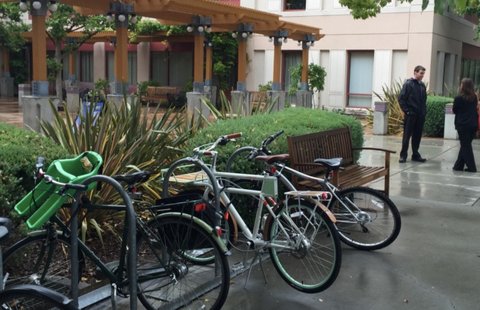Speedy Cycles

With the ability to travel up to 20 miles per hour, speed past traffic, and get commuters to work without breaking a sweat, e-bikes are a growing trend. But changing habits, especially driving habits, is hard to do.
Cindy Jiang, MS ’16, is a Stanford environmental engineering major who has long been drawn to transportation conundrums. She wants to know what factors affect consumer use of e-bikes and e-scooters, so she decided to take a closer look in her yearlong ENVRES 255: Innovative Transportation Systems class.
With financial backing from the TomKat Center for Sustainable Energy, a pilot project began to take shape on Stanford’s campus in 2015, and she found willing partners in San Francisco–based Faraday Bicycles and scooter manufacturer EcoReco.

In some respects, her role in the pilot has been like a wildlife biologist tracking the migratory patterns of Stanford employees.
Through the five-week pilot, 40 participants had the chance to test-drive both an e-bike and e-scooter and find ways to incorporate them into their daily lives. In return, they agreed to complete commuting logs and install a GPS app on their smart phone or wear a GPS watch that allowed researchers to track their comings and goings. Nearly all of the participants lived within three to five miles of campus.
Enjoying the ride
“The scooter is amazingly fun—especially passing bikers,” says Charles Lee, the Moghadam Family Professor of Management, who used the e-scooter to commute 4.5 miles along a bike path to the Stanford Graduate School of Business.

At first glance, the electric models seem like the ordinary bicycles and scooters you might see neighborhood kids riding—until you notice their speed. “It looked a little scary at first, but I never felt unsafe because I was only a few inches off the ground,” Lee says.
The e-bikes and e-scooters do come with concerns. Theft was a top concern, especially for the e-bike, which was more difficult to lock up in an office, locker, or car trunk. Price was another factor. And then there was the occasional user error.
Vannina Champenois, microbiology lab administrator in the School of Engineering, confesses that she didn’t properly charge the e-bike initially and she spent the first two days pedaling it on her own without realizing it. “I had this fantastic placebo effect where I thought I was being helped!”
For the past 20 years she had been driving her kids around in a minivan, but her youngest recently got a driver’s license, so the chance to join the pilot came at the perfect time.
“The bike is so comfortable, that it was pleasant even without the battery,” she says.
Moving in the fresh air, study participants may have found that the greatest change in their commute couldn’t be quantified with numbers. As author James E. Starr has put it: “Melancholy is incompatible with bicycling.”
Diving into the data
Here’s what the pilot discovered:
- Overall, participants made fewer car trips per week. The number of participants who drove at least twice a day dropped by 45 percent.
- Interestingly, the e-scooters and e-bikes fit different commuting niches.
- E-scooters were preferred for trips under two miles. They have the advantage of folding neatly into the trunk of a car. Participants tended to use them for quick midday errands.
- E-bikes were found to be better for longer trips; pilot participants traveled an average of 5.4 miles when they took the e-bike out for a spin, often for their morning and evening commutes.
- Perhaps the greatest measure of success was that four participants bought the e-bike and seven participants bought the e-scooter at the conclusion of the pilot.
This project was funded through a TomKat energyCatalyst grant.



